The following posts from spring 2010 will help kickstart this topic as we head towards spring 2011.
Two photos of Iris cristata 'Sam's Mini', a low growing and floriferous variety found by Sam Norris of Kentucky.
The next photos show the early spring rhizomes when first emerging. The rhizomes run on top of the soil, in fact, they prefer to slowly romp through the top layer of woodland duff or well decomposed bark mulch. In this particular cultivar, the rhizomes amusingly look like they're leaping up and over like spawning salmon as they progress upstream.
Having never harvested seed on Iris cristata, I wanted to experiment with seed-grown plants to see what sort of variability could be expected. I also needed to learn how to harvest the seed; when is the seed ready? Every few days I picked a pod and snapped it in half to test the progress of developing seed inside. Eventually a few pods started to show a small degree of whitening in color, and a few other pods actually dropped off (although remained unopened), surely ready to pick. The succulent green pods of Iris cristata and some Chinese woodland irises are attractive to some sort of insect that gets to the pods before fully ripe; dastardly chipmunks & squirrels munch them too, so harvesting early when the seed is ripe enough makes sense.
In the photo on the left showing the seed pods, on the right notice the lobster-claw like leaf bracts that each hold twin seed pods, the long styles are persistent. Initially when testing seed for readiness, the seeds were nearly clear or translucent... so I waited until they were a semi-translucent to nearly opaque tan or yellow color. Harvesting the seed is as easy as snapping the pods in half, then gently squeezing the seed out. They were sown fairly thick in flats, covered with fine decomposed pine bark mulch, covered with wire mesh to prevent digging by chipmunks and squirrels, and they'll spend the year outside, hopefully to germinate spring 2011.
Comments
Re: Iris cristata and small woodland Iris
I've never had good luck harvesting seed on Chinese Iris species. It helps being retired (wish I was) or unemployed (wish I wasn't, sort of), because I get to observe in much more timely detail about what plants are up to. Year after year, I see big, fat, 3-sided pods on species like Iris koreana and I. odaesanensis, two wonderful Chinese woodland Iris species, but rarely ever get any seed, although do find seedlings of I. odaesanensis here and there.
I discovered that the seed pods are much like other ephemeral seeders such as Jeffersonia, Epimedium, and Corydalis, they are actually ripe and mature when they're still green, when they're "al dente" and not "fully cooked", but even more so with Iris koreana. Harvesting the large seed pods while green (noticing that a few had gone over to yellow, but with nothing inside), and snapping the green pods in half, there's good seed in there, like golden kernels of corn with starchy appendages (elaiosomes) that are attractive to ants.
Iris koreana does a pretty good emulation of I. cristata, only with yellow flowers. Darrell Probst tells me that he has tried crossing the two species, but thus far no hybrids. One reason I'm interested in growing on the seed, maybe the bees will have better luck.
I also collected seed on I. odaesanensis and I. henryi much earlier that I would normally, and found a good percentage of viable looking seed. Time will tell whether my early seed sowing efforts are the proper recipe for success. Iris koreana was blooming at the same time, and within close proximity of I. cristata 'Edgar Anderson', so I'm interested in finding out whether the bees were up to any productive hanky-panky.
Re: Iris cristata and small woodland Iris
Iris minutoaurea took several years to "settle down" before it started to flower well. In 2010 there was a fairly good flowering (2 photos), but the plant is being encroached upon and shaded by Epimedium x setosum; eventually I moved the Epimedium to afford more room for the Iris. No seed again this year, it got very hot when the plants bloomed and they went over too quickly. I always forget to use some sort of scale object when photographing this plant, as it is so tiny in flower that it is hard to capture a true sense of scale.
Both I. koreana (left) and I. minutoaurea (right) have the undesirable habit of expanding their foliage significantly after flowering, making larger (and untidy) foliage clumps than one anticipates, as compared to I. cristata that maintains the spring foliage size.
Re: Iris cristata and small woodland Iris
I have never grown Iris cristata in pots, but have heard they are not the most amenable creatures for pot culture. Here in New England, northeastern USA, they are among the easiest and most satisfying Iris to grow, rapidly spreading and flowering prolifically. The mistake people sometimes make with them, is to plant the rhizomes too deep. As you can see in the rhizome views I have shown, they like to run right on the surface, so are best planted in a layer of woodland duff or decomposed bark mulch.
Typically they make lots of seed, but I've never bothered collect seed until spring 2010. My large mat of I. cristata 'Shenandoah Sky' growing under a Stewartia pseudocamelia tree, flowered prolifically as always (photo from 2008), but with several days of unusual heat (94 F - 35C) the flowers went over quickly and made no seed at all, I suspect because the process of fertilization did not have enough time as the flowers were toasted.
Same thing with two newbies in the garden, I. cristata 'Mountain Girl' (left) and I. cristata alba (right). Both were planted in 2009, as 2-fan starts, and I'm pleased with how much they grew in just one year, and flowered spring 2010, but the flowers were no match for the heat. I was lucky to get one pod on alba even with the heat. The one named 'Mountain Girl' is a 2007 introduction by Joe Pye Weed's Garden (Marty Schafer & Jan Sacks, breeders of amazing Iris), lovely light blue flowers lacking any yellow among the white signal patches.
Re: Iris cristata and small woodland Iris
I have I. henryi and I. odaesanensis growing on a dry embankment, I. henryi seems to love the location, with about 200 blooms in 2010 (but only 4 plump seed pods) and for some reason the same year, I. odaesanensis barely bloomed at all, I think just 3 flowers, although the plant has spread to about a meter across and looks healthy otherwise. I might split it and try growing some pieces in a more moist location. Iris henryi and I. odaesanensis seem to grow as "turf" species, the old foliage persistent (evergreen, but still persistent in I. henryi), and in spring grow out of the mass of older foliage.
left photo: March 2010, enbankment with I. henryi on the left, the evergreen foliage trailing down nearly 2' (60 cm), with the dead persistent foliage of I. odaesanensis on the right (don't even think about foliage cleanup, not worth the tedious effort).
right photo: late April 2010, the plants coming to life, I. henryi budded (lots of buds), and new foliage of Iris odaesanensis in the background, taking over the persistent old foliage.
Iris henryi, lots and lots of bloom, about 200 flowers. This is a bi-flowered species, and a couple days after the first flush, it repeats itself with a second flush of the same number of flowers. The flower color is the palest smokey blue, hard to capture in photos, but exquisite in every detail.
Iris henryi, setting lots of pods, but a false promise, as only 4 out of hundreds of pods would end swelling into a round lime-like ball to produce seed; in this photo one swelling pod can be seen.
Foliage of I. henryi and I. odaesanensis taken mid June 2010, really good on a slope where the foliage hangs down to follow the slope.
A photo from October 2008, showing the embankment after we've had some frost, the very narrow grass-like leaves of I. henryi on the left looking very much like the leaves on Carex caryophyllea on the right, with the turfy mass of I. odaesanensis taking on some yellow frost-induced color in the center.
Re: Iris cristata and small woodland Iris
China has many lovely woodland Iris. At a 2010 garden tour at Joe Pye Weed's Garden, the amazing garden and nursery of Marty Schafer and Jan Sacks here in Massachusetts, USA, there was a planting with numerous Darrell Probst Iris collections from China. I show just one such collection in bloom that day, a gorgeous little woodland Iris, among many listed as "Iris species novum" along with a collection number. I hope some of these lovelies make it into horticultural commerce soon, and knowing of Jan & Marty's cultivation skills, and of Darrell's, maybe we won't have to wait too long.
There were many such clumps of various Iris species novum there; one had black stems and striking black bud spathes, the outer side of the ready-to-pop buds were light yellow, although Darrell assures me it opens to a light blue flower. My photos came out lousy, so I only show one photo of another Iris species novum.
Also shown is Iris gracilipes 'Cobblewood Charm', a 2008 Joe Pye Weed's garden introduction, a cross between the I. gracilipes "Buko Form" (tiny miniature white form, found on Buko San [mountain] in Japan) and the regular taller blue-violet form. In flower it is about 6-8" (15-20 cm) tall.
Re: Iris cristata and small woodland Iris
In June 2010 I divided a clump of Iris cristata alba, and thought it might be a good opportunity for photo documentation.
In the upper center is I. cristata alba. The previous year it was a two-fan plant, purchased from Garden Vision Epimedium in May 2009, for $6 US. Certainly has filled out nicely in just one year. To the left of it is a similar size clump of I. cristata 'Mountain Girl', and to the right the tiny plants are seedlings. These plants grow at the base of Stewartia pseudocamellia, a tree with incredibly dense matting surface roots that make underplanting impossible for most plants, but Iris cristata can easily skim the surface bark mulch layer. In this photo, I used a sharp spade and trowel to mix the existing mulch layer into the loosened earth, the surface tree roots chopped out just to give the Iris divisions one season of competition-free growing.
Iris cristata alba clump uprooted. Don't be fooled by the seemingly dense root ball, most of those roots are Stewartia tree roots!
Typical division; usually the fans are paired, sometimes there is a third side fan. In the center of paired fans is the spent bloom stalk and bracts. Most roots are from the older joined portion of rhizome, but you can also see a couple new white roots emerging from the two fans, ready to dig in and anchor those fans, later this season to sprout forth with fresh new paired fans advancing the colony.
Left: close-up of the paired fans and just-emerging anchor roots.
Right: paired fans spaced and ready to plant, with 14 divisions, a 14:1 increase in 1 year.
Divisions planted and watered in. It's hard to tell, but the rhizomes are left on the surface or just barely covered, but I do carefully place soil/mulch over the new anchor roots. These divisions will get special attention and watering for the next month.
In the center, a 2-year seedling with 5 closely spaced fans that are attached to a developing rhizome, and a 1-year seedling on the right that germinated last summer; it does not have a developed rhizome yet. I photographed these with the adult-size fans in view, to give an idea of size of these youngsters.
Re: Iris cristata and small woodland Iris
Interesting profile, I'll be watching for any of these that might be hardy enough; I like species Iris, and anything with 'woodland' in the description is a good starting point for me.. I don't mind the 'turf' effects, and plenty of space to let them do their thing...
Re: Iris cristata and small woodland Iris
Very interesting, Mark!
I have for years thought to start growing some of these irises. No you have persuaded me to make an attempt this summer ;D - if I can lay may hands of some nice plants! Too long to wait for seedlings to grow.
Re: Iris cristata and small woodland Iris
Thanks for this Mark. Very informative and it gives me inspiration & confidence to get out & collect seed from my Iris cristata 'Powder Blue Giant' and 'Alba' this spring! I purchased an I. odeasanensis from Jan & Marty last year at the EWWSW and I'm looking froward to seeing its bloom!
Re: Iris cristata and small woodland Iris
VERY nice, Mark.
You're going to get me hooked on a new plant-addiction (and I already have to many ;)). I wonder where I can find these in Europe...
I like Iris cristata 'Sam's Mini', Iris minutoaurea and Iris species novum the most.
Re: Iris cristata and small woodland Iris
For some reason I have no luck with Iris cristata :-[
Re: Iris cristata and small woodland Iris
I've never managed to winter I. cristata over here either, maybe for different reasons - who knows? Do other Calgarians out there grow it successfully?
Re: Iris cristata and small woodland Iris
Hmm, I have never given it a second thought, about Iris cristata hardiness. They never show the slightest indication of winter kill, so I just assumed if they perform this well in USDA Zone 5, they might do nearly as well in Zone 4. Checking the USDA Plant Profile for Iris cristata, I see that it is definitely a Eastern USA species centered in central to southern States, with a disjunct distribution to include little ol' Massachusetts (in USDA, Massachusetts not included in FNA). So it surprises me to learn it is not growable in Alberta nor Newfoundland!
http://plants.usda.gov/java/profile?symbol=IRCR
Re: Iris cristata and small woodland Iris
I have never tried it over here, Mark, but if I get the chance I'll give it a try both at home and at my seaside cabin.
Re: Iris cristata and small woodland Iris
I don't think hardiness is a problem here...I just don't seem to have the right conditions...frost heaving is a b***h around here and Iris cristata with its rather shallow roots, gets nailed. I think we have one member in our society that grows it in her actual woodland, among Cornus canadensis, Clintonia borealis and Trilliums. She can also grow Soldanella, another species I have absolutely no luck with.
Re: Iris cristata and small woodland Iris
I hardly give Iris cristata a second thought here, just like Mark. It does its thing without any special care. At least for Todd, outright cold can't be the deciding factor. He has warmer winters than me. The only thing I have found with Iris cristata is transplanting in fall is usually deadly. But that's apparently not so uncommon in that iris section or with bearded irises.
Iris lacustris is carefree here, too.
Re: Iris cristata and small woodland Iris
Rick, I think you hit the nail on the head, late planting is fatal with them. In my photo exposé of dividing and planting Iris cristata, the exercise took place on Jun 21, 2010. This is a point after flowering where new rhizomes above the soil have expanded and just starting to tap down into the soil with "anchor roots" (the photo of an uprooted division shows this), the best time to divide. Since the rhizomes basically sit on top of the soil, they depend on well developed and mature "anchor roots" to get them through the winter.
Last winter we had much less snow and I photographed the bare ground where a large patch of Iris cristata 'Shenandoah Sky' grows under a Stewartia pseudocamellia tree. In January & February I'd look at the exposed rhizomes and cringe, but they do just fine. 2010 was an exceptionally early spring, here is the bare mass of rhizomes in March.
Close by I have an old clump of Iris gracilipes "Buko Form", a tiny miniature form with white flowers. Since it was an early spring, I got over anxious and cleaned up the old foliage, which makes a thatch concealing the budded rhizomes. It was a mistake. A day after the cleanup, we had a deep freeze, and slowly over the next few weeks, parts of the large clump starting dying off. Eventually I only saved a small piece... fortunately I had a few 2-3 year seedlings coming along. A friend warned me the year before, "you really should divide up that clump", but I got lazy and didn't do it. The seedlings had no problem with the sudden cold snap.
Next to it I grow Iris gracilipes 'Cobblewood Charm', a hybrid by Darrell Probst of "Buko Form" with the regular larger I. gracilipes. It too had no problem with the cold snap, even though I cleaned up the thatch. While the emerging rhizomes of the "Buko Form" and 'Cobblewood Charm' look the same size, the "Buko Form" ones are minuscule! My attempt at getting a good side by side comparison photo didn't work too well, so in the last shot I overlaid the image of 'Cobblewood Charm' at the same scale, to be closer to the "Buko Form" 2-3yr plant, to show the difference in shoot size.
Re: Iris cristata and small woodland Iris
It was a mistake. A day after the cleanup, we had a deep freeze, and slowly over the next few weeks, parts of the large clump[of Buko Form] starting dying off. Eventually I only saved a small piece... The seedlings had no problem with the sudden cold snap.
Mark,
Did you do anything to "save" the remaining Buko Form, or just let nature take its course?
And had you cleaned the seedlings too, and they still sruvived? Maybe there just wasn't much old foliage for protection anyway.
Re: Iris cristata and small woodland Iris
Mark,
Did you do anything to "save" the remaining Buko Form, or just let nature take its course?
And had you cleaned the seedlings too, and they still survived? Maybe there just wasn't much old foliage for protection anyway.
Yes, I tried to save it, divided up the entire clump and replanted smaller pieces, but the growth points just sat there and most shriveled away. I got only one remnant piece to survive. The super hot & dry summer didn't help, even though I watered the divisions religiously.
The 2 & 3 year seedling plants had been "de-thatched" too, but were okay with the sudden deep freeze. I think the mother plant's rhizomes had just become too large, dense, and weakened with age, and were in need of division years before.
Re: Iris cristata and small woodland Iris
A few repeats, but they are all so comely this season that I snapped some photos. Does anyone get Iris cristata seeding around much? I rarely get seedlings, even with lots of seed-filled pods typically produced, but I hypothesize these largely get eaten, they seem a favorite of squirrels and chipmunks. But a do have a few self-sown seedlings, here's one that is flowering for the first time, nothing special, just a nice light slate blue.
Two Iris cristata forms in opposing forms, both are the earliest cultivars to bloom. The first set of photos is 'Sam's Mini', very low growing and neat, excellent low arching foliage, and highly floriferous. A strong fast spreader too. The second set of photos is 'Edgar Anderson', the relative GIANT form, also making fine foliage mats but much larger and taller, and floriferous with crystalline frilly-edged mid blue flowers. Exploring cultivars such as these is a good reminder just how variable a plant species can be, and gardeners certainly do horticulture a service by recognizing these differences and embracing the more unique forms. It is worth noting, all Iris cristata forms survived last year's record breaking drought without a scratch.
Iris cristata 'Sam's Mini'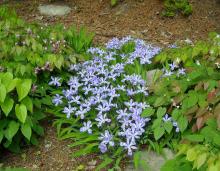
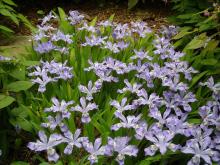
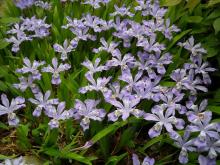
Iris cristata 'Edgar Anderson': the 2 photos on the right in early morning sunlight, making the flowers appear more blue.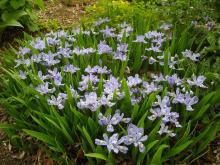
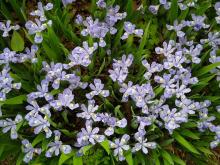
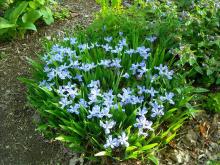
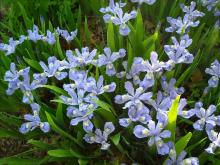
The flowering of Iris henryi (left) was somewhat ruined by extended periods of rain, and I missed much of the flowering while I was traveling, managed to get a snapshot one rain morning. Same with yellow Iris minutoaurea (right). This one is starting to flower less, I believe it needs to be divided and replanted to "refresh" the plants for better growth and flowering in the future. I. henryi is also earmarked for division.
Re: Iris cristata and small woodland Iris
Looking around the garden recently, I noticed how different some of the leaf forms of Iris cristata can be. In the photo on the left is I. cristata 'Shenandoah Sky', with fairly broad leaves with gracefully arching tips. In the photo on the right, you can see 'Shenandoah Sky' on the left side of the photo, and in the center foreground is I. cristata 'Mountain Girl', with bold narrow-leaved sharp fans of foliage; quite a different look about it. On the upper right is I. cristata 'Alba' with the more typical arching leaves.
Re: Iris cristata and small woodland Iris
My original Iris odaesanensis has flowered poorly the last couple years, barely at all. So I'm trying them in various spots in the garden to find a spot more to its liking. In this view, is a seedling grown plant, which actually flowered this year (4 yrs from seed) with a couple white flowers. I noticed that in late summer and fall, the rhizomes bulk up with lots of narrow blue-green fans and shoots... I think they take a while to become established.
Re: Iris cristata and small woodland Iris
I'm not sure how I missed this thread earlier, but your irises are just incredible, Mark! :o :o
Re: Iris cristata and small woodland Iris
These Iris are such easy-doers here... pot up an Iris cristata form and try to sell it for 1$ or even just 50 cents at a New England NARGS meeting, and it's like trying to sell some weeds, no one wants them because they're so commonplace here. I find them all totally delightful and satisfying regardless.
Re: Iris cristata and small woodland Iris
I potted up some Iris cristata in the spring a few years ago and forced them the following winter very successfully with just natural light. They were blooming door prizes at an early March NARGS Minnesota chapter banquet. Bill Dougherty of Summer Chase Gardens spoke on iris. He is very good. Iris that I potted up in late summer/early fall did not survive.
So if you have an overabundance, you can play with them in the winter, too.
Re: Iris cristata and small woodland Iris
These Iris are such easy-doers here... pot up an Iris cristata form and try to sell it for 1$ or even just 50 cents at a New England NARGS meeting, and it's like trying to sell some weeds, no one wants them because they're so commonplace here. I find them all totally delightful and satisfying regardless.
:o :o
Just come and sell them over here, Mark. You could ask 5 euro's for a pot of I. cristata and they'll sell very easily...
Re: Iris cristata and small woodland Iris
Just come and sell them over here, Mark. You could ask 5 euro's for a pot of I. cristata and they'll sell very easily...
True enough, but it would probably cost 10 euros per pot to ship them ;)
Funny how in a global context, some plants receive little fanfare while elsewhere the same plants can be coveted.
Re: Iris cristata and small woodland Iris
Iris 'Eco Little Bluebird' is showing a flower now, a bit out of season :rolleyes:
Re: Iris cristata and small woodland Iris
Excellent! I've never had one of these through a bloom in the fall. Since we were talking about how much a named Iris cristata might cost in Europe, how much did you get it for, or was it shared by a friend. With the name 'Eco Little Bluebird' this has to be one named by Don Jacobs from Decatur Georgia (Eco Gardens)... all his named selections are named in the form of Eco-this or Eco-that.
Re: Iris cristata and small woodland Iris
I don't think I have ever had an Iris cristata bloom out of season.
all his named selections are named in the form of Eco-this or Eco-that.
I actually like the Eco- this/that, Lakeside this/that, this/that zam system. It tells me more about the cultivars at a glance.
Re: Iris cristata and small woodland Iris
Excellent! I've never had one of these through a bloom in the fall. Since we were talking about how much a named Iris cristata might cost in Europe, how much did you get it for, or was it shared by a friend. With the name 'Eco Little Bluebird' this has to be one named by Don Jacobs from Decatur Georgia (Eco Gardens)... all his named selections are named in the form of Eco-this or Eco-that.
Mark,
it's a selection from Don Jacobs indeed. I bought it for only 5 euro's from a local nursery....not very expensive :D but it was the only cultivar they were selling...they don't grow any other I. cristata cultivars.
BTW, they sold it as I. 'Little Bluebird'. But after a search on the web...it was clear the original name was "ECO little Bluebird'
Re: Iris cristata and small woodland Iris
Wim, then it was a "good find" to come across a named form. Most of mine are "shutting down" for the season, with the leaves yellowing and passing into dormancy. Iris verna on the other hand, is looking spiffy and perky with dark shiny foliage. In the photo taken today is I. verna var. smalliana 'Brumback Blue' that I purchased from Garden Vision Epimediums this spring, it was $8.00. It was past flowering season when I bought it, but I'm pleased that it has already more than doubled in size with more low-ascending fans. This cultivar is supposed to be a "prolific bloomer" so I'm anxious to see flowers next spring.
Some links on Iris verna and its two varieties (var. smalliana, var. verna)
http://www.fs.fed.us/wildflowers/beauty/iris/dwarfwoodland/iris_verna.shtml
http://plants.usda.gov/java/profile?symbol=IRVE
http://plants.usda.gov/java/profile?symbol=IRVES
http://efloras.org/object_page.aspx?object_id=8461&flora_id=1
Flower photos, the best forms are deep blue and have bold gold flare spots:
http://www.flickr.com/photos/alan_cressler/3464938050/
http://www.flickr.com/photos/22032600@N04/5614180632/
Re: Iris cristata and small woodland Iris
Wim, then it was a "good find" to come across a named form.
Yeah, I thought so too ;D ;D
Iris verna on the other hand, is looking spiffy and perky with dark shiny foliage. In the photo taken today is I. verna var. smalliana 'Brumback Blue' that I purchased from Garden Vision Epimediums this spring, it was $8.00. It was past flowering season when I bought it, but I'm pleased that it has already more than doubled in size with more low-ascending fans. This cultivar is supposed to be a "prolific bloomer" so I'm anxious to see flowers next spring.
Some links on Iris verna and its two varieties (var. smalliana, var. verna)
http://www.fs.fed.us/wildflowers/beauty/iris/dwarfwoodland/iris_verna.shtml
http://plants.usda.gov/java/profile?symbol=IRVE
http://plants.usda.gov/java/profile?symbol=IRVES
http://efloras.org/object_page.aspx?object_id=8461&flora_id=1Flower photos, the best forms are deep blue and have bold gold flare spots:
http://tenn.bio.utk.edu/vascular/database/vascular-photos-enlarge.asp?CategoryID=Monocots&FamilyID=Iridaceae&GenusID=Iris&SpeciesID=verna%20var.%20smalliana&PhotoNameID=ir_vern&PhotographerNameID=Mark%20Pistrang
http://tenn.bio.utk.edu/vascular/database/vascular-photos-enlarge.asp?CategoryID=Monocots&FamilyID=Iridaceae&GenusID=Iris&SpeciesID=verna%20var.%20smalliana&PhotoNameID=ir_vern_smal1&PhotographerNameID=B.%20Eugene%20Wofford
http://www.flickr.com/photos/alan_cressler/3464938050/
http://www.flickr.com/photos/22032600@N04/5614180632/
Wow,
just took a look at the flower-pics. That's a very nice species, I'll be on the lookout for that one.
Re: Iris cristata and small woodland Iris
On this cold mid November day, I took a photo showing the difference between Iris henryi on the left (very narrow foliage, evergreen) and I. odaesanensis on the right (persistant dried remains of foliage, not evergreen). Both species are planted at the top of a mound, so they are grown rather dry. Plants of Iris odaesanensis on flat ground elsewhere in the garden have leaves in a semi-dormant state... some green at the base but drying and going into dormancy, but with strong green shoots in evidence at the base.
Iris minutoaurea, one of the tiniest Iris in bloom, has surprisingly long foliage after bloom, that persists all season long. In this photo you can see it has mostly gone brown and drying, but it is extremely tough and persistent, and must be cut off in spring to enjoy the best display in sping. This clump is long overdue for being divided.
Re: Iris cristata and small woodland Iris
The wonderful Iris koreana is in splendid bloom right now, fully a month earlier than normal due to our extra warm spring season. Iris koreana and I. odaesanensis are species that Darrell Probst has introduced from Korea, and glad he did, because they are easy and delightful small woodland plants, a perfect compliment to our familiar woodland Iris such as I. cristata.
http://www.signa.org/index.pl?Iris-koreana
http://www.signa.org/index.pl?Iris-odaesanensis
http://www.plantdelights.com/Iris-odaesanensis-Perennial-Mt-Odae-Iris/pr...
This clump of I. koreana has grown well and spread to a sizeable clump in three years. Before that, I had it planted in another location where it was shrinking in size and barely bloomed; probably too dry a location previously. Funny, the buds opened on the south side of the clump first, and now progressing south to north :D
As I'm only able to catch a few photo after work at dusk, the photos are a bit dark, maybe I'll get a better photo today (weekend day) with better light.
Re: Iris cristata and small woodland Iris
To compare, here is the other Korean species, Iris odaesanensis, apparently named for a Mt. Odae in Korea where the species is found. I have a large patch that used to flower well, but no longer flowers, or sputters out only a couple of blooms. The patch shown in the first photo is a combination of some self-sown seedlings, and a few seed-grown plants from my sowing, the division between my two groupings now grown in and merged into one patch. This year it has a smattering of blooms, but not a shear mass of bloom as I have seen them at Garden Vision Epimediums nursery, not sure what will stimulate better bloom. My plan is to move them around to various parts of the garden to find a spot to its liking, as has happened with Iris koreana.
Iris odaesanensis. Notice the yellow spot or halo in the closeup view. Darrell Probst also selected a form that looks similar, except for a fine brown line around the yellow halo, both forms have been available from Garden Vision Epimedium.
A closeup of Iris koreana today:
Re: Iris cristata and small woodland Iris
Your irises are spectacular, Mark! I wonder how hardy those species are? Can anyone comment?
Re: Iris cristata and small woodland Iris
They are darling, Mark.
I have some year old seedlings of odaesanensis and koreana from SIGNA seed that I will be planting out this spring. We'll see how they do.
Mark, keep us informed if you make anymore determinations regarding climate preference. I think we would all benefit.
Iris minutoaurea will be making a show soon...
Re: Iris cristata and small woodland Iris
Great Irises, Mark :)
Lori, if you find out, let me know ;D
Re: Iris cristata and small woodland Iris
Your irises are spectacular, Mark! I wonder how hardy those species are? Can anyone comment?
Regarding hardiness, they certainly have no problem with Zone 5, so maybe try them in Zone 4. So far as getting shy-flowering species to flower more, I know that Garden Vision Epimediums has actually selected a form of I. koreana for its free flowering capability. Yet for me, just moving it to a different spot meant the difference between a plant that refused to flower to one that flowers in spectacular fashion, yet I have little idea about what accounts for the difference, other than being is a spot not so dry, yet the new spot is still on the dry side.
If I find out what makes I. odaesanensis flower better, I shall certainly report back.
Re: Iris cristata and small woodland Iris
Hope you find a spot to its likening, Mark! It's beautiful! The both are, of course ;)
Re: Iris cristata and small woodland Iris
There you go again, making me jealous with those wonderful shade-loving Irisses which are impossible to find in Europe! :-[ :-[ :'(
Re: Iris cristata and small woodland Iris
There you go again, making me jealous with those wonderful shade-loving Irisses which are impossible to find in Europe! :-[ :-[ :'(
Maybe there will be some seed set this year (last year there was none, on both species). With I. koreana, even with good seed set in the past, so far I've only had 1 seedling ever germinate! With odaesanensis I've had slightly better results.
Re: Iris cristata and small woodland Iris
There you go again, making me jealous with those wonderful shade-loving Irisses which are impossible to find in Europe! :-[ :-[ :'(
Maybe there will be some seed set this year (last year there was none, on both species). With I. koreana, even with good seed set in the past, so far I've only had 1 seedling ever germinate! With odaesanensis I've had slightly better results.
;D
Don't worry Mark. I'm sure I'l find it sooner or later!
Re: Iris cristata and small woodland Iris
Flowers are a bit shorter this year due to the dry spring (and winter): 2 inches high, as oppose to the usual 3 inches.
Iris minutoaurea, given to me as a seedling Iris sanguinea by a fellow NARGS chapter member. Had she known what she had, she may not have been so generous!
Re: Iris cristata and small woodland Iris
That's a sweet one, Rick!
Re: Iris cristata and small woodland Iris
That's a sweet one, Rick!
My mature clump of Iris minutoaurea must need division, because instead of smothering itself in flowers as it has in the past, it only has a sprinkling of 10-12 tiny blooms. Rick, glad you got a good photo of yours. After a long dry spell, it rained pretty good yesterday, thus the crummy photo I'm showing, and then overnight the heavens let loose with deluge downpours and wild winds; everything is beaten down from the downpours. Iris koreana was at near peak, glad I got some good photos while the weather was better, before squashed from the downpours.
Anyway, I uploaded this photo of I. minutoaurea, to give a sense of scale, the flowers aren't much bigger than my thumbnail? Do you think this tightly clumping Iris get too congested, and that's the reason for the floral decline?
Just noticed the first bloom on I. henryi is partially open, and the form of I. odaesanensis with the brown-rimmed signal spot is budded at long last.
Re: Iris cristata and small woodland Iris
I received it as a first year seedling in 2005 - not long enough to know if it needs periodic division. It only began flowering in 2009, a long wait for an iris, in my opinion. There are a lot of advantages to having photographic records of your plant materials. Here's a progression of the one plant:
Mine are bigger than my thumb. :D The flower measures exactly one inch across.
Re: Iris cristata and small woodland Iris
I must have fat thumbs ;). Interesting to see that annual progression, I can detect the tendency for this iris species to create a "rhizome donut", with flowers and growth moving to the outer ring.
Re: Iris cristata and small woodland Iris
Interesting to see that annual progression, I can detect the tendency for this iris species to create a "rhizome donut", with flowers and growth moving to the outer ring.
Probably. Is this how Iris minutoaurea behaves for you, Mark? After I took the photo, I remove the leaves in the middle, and there was still some green in the very center.
Re: Iris cristata and small woodland Iris
Mine are bigger than my thumb. :D The flower measures exactly one inch across.
Isn't an inch defined as the width of a thumb ;)
A very nice species anyway!
Re: Iris cristata and small woodland Iris
Today was my annual field trip to Garden Vision Epimediums "open nursery weekend"; a fine spring day. Not only are there epimediums, but also some nice woodland Iris. The photos show a booty box of newly purchased treasures. The biggest surprise was I. cristata 'Montrose White', a 2010 Joe Pye Weed's Garden 2010 introduction. The beautiful flowers are really large, surprisingly so, 3" diameter. It is said to be a robust grower.
One that I lost due to mole/vole tunneling is I. cristata 'Powder Blue Giant', with 3-1/2" light blue flowers, happy to get it back for a mere $6.
Two others I bought were I. cristata 'Little Jay', a dwarf deep blue selection, and I. verna 'Cleo Chapel Road', a 2012 Joe Pye Weed's Garden introduction, a colorful form collected bt Darrell Probst near Cleo Chapel Road, South Carolina.
Re: Iris cristata and small woodland Iris
Nice batch of plants- sounds like a great event to attend :) What are the pink flowers- first glance I was thinking Phalaenopsis (tropical orchids), which of course can't be...lol
Re: Iris cristata and small woodland Iris
I. cristata 'Montrose White'
I. cristata 'Powder Blue Giant'
I. cristata 'Little Jay'
I. verna 'Cleo Chapel Road'
Sigh.... :-\ :rolleyes:
Re: Iris cristata and small woodland Iris
Nice batch of plants- sounds like a great event to attend :) What are the pink flowers- first glance I was thinking Phalaenopsis (tropical orchids), which of course can't be...lol
The pink flowered plant is Phlox stolonifera 'Wister Pink'. All of these carpeting woodland phlox are wonderful garden plants, easy and indestructable, but as the name implies (stolonifera) it's a spreader, and must be given room to spread. There are many many named cultivars of this Eastern USA species. Here's a photo showing the plant and the creeping stoloniferous runners.
Re: Iris cristata and small woodland Iris
I'll have to catch up with some more Iris that have bloomed, but I'll jump ahead with one I found in bloom tonight. When I get home in waning light, I do my "garden walkabout" and I find new things in flowers. Here's Iris verna 'Brumback Blue', a wonderful dwarf woodland species, this one selected for its bright color. I'm so pleased to see the first flowers open.
Re: Iris cristata and small woodland Iris
Nice batch of plants- sounds like a great event to attend :) What are the pink flowers- first glance I was thinking Phalaenopsis (tropical orchids), which of course can't be...lol
The pink flowered plant is Phlox stolonifera 'Wister Pink'. All of these carpeting woodland phlox are wonderful garden plants, easy and indestructable, but as the name implies (stolonifera) it's a spreader, and must be given room to spread. There are many many named cultivars of this Eastern USA species. Here's a photo showing the plant and the creeping stoloniferous runners.
[attachthumb=1]
Interesting, don't think I've seen any of these, something to look into and watch for if they are hardy enough..
Re: Iris cristata and small woodland Iris
Nice batch of plants- sounds like a great event to attend :) What are the pink flowers- first glance I was thinking Phalaenopsis (tropical orchids), which of course can't be...lol
The pink flowered plant is Phlox stolonifera 'Wister Pink'. All of these carpeting woodland phlox are wonderful garden plants, easy and indestructable, but as the name implies (stolonifera) it's a spreader, and must be given room to spread. There are many many named cultivars of this Eastern USA species. Here's a photo showing the plant and the creeping stoloniferous runners.
[attachthumb=1]
Interesting, don't think I've seen any of these, something to look into and watch for if they are hardy enough..
Phlox stolonifera is completely hardy here, Cohan.
Re: Iris cristata and small woodland Iris
The pink flowered plant is Phlox stolonifera 'Wister Pink'. All of these carpeting woodland phlox are wonderful garden plants, easy and indestructable, but as the name implies (stolonifera) it's a spreader, and must be given room to spread. There are many many named cultivars of this Eastern USA species. Here's a photo showing the plant and the creeping stoloniferous runners.
I wish they were indestructable! I have tried several forms of stolonifera and would love to see them going rampant in my woodland. No chance. Slugs :(
Re: Iris cristata and small woodland Iris
Nice batch of plants- sounds like a great event to attend :) What are the pink flowers- first glance I was thinking Phalaenopsis (tropical orchids), which of course can't be...lol
The pink flowered plant is Phlox stolonifera 'Wister Pink'. All of these carpeting woodland phlox are wonderful garden plants, easy and indestructable, but as the name implies (stolonifera) it's a spreader, and must be given room to spread. There are many many named cultivars of this Eastern USA species. Here's a photo showing the plant and the creeping stoloniferous runners.
Interesting, don't think I've seen any of these, something to look into and watch for if they are hardy enough..
Phlox stolonifera is completely hardy here, Cohan.
Thanks, Lori, definitely one to watch for then, though a quick search tells me I need to be careful of the colour of the cultivar- some are a little too similar in colour to the Geranium himalayense we have so much of in one of my least favourite shades....lol ( a sort of electric purply blue- I like violet, I like pink, I like blue, just not that particular shade of any of them!)
Re: Iris cristata and small woodland Iris
Those irises are delectable - especially minutoaurea which is completely new to me. Great photos of Rick's and Mark's - are there other species with such small but perfect flowers? I've always liked the Pacific Coast Irises but they are not that widely grown here - good balance of foliage and flowers.
Re: Iris cristata and small woodland Iris
Iris gracilipes is another nice little one. I grow the white form:
Rick, good portraits, the white form of gracilipes is such a beauty. I have forms of I. gracilipes growing among so many other things that I can't quite adequately capture the delicate graceful growth of the plant, with such fine stems arching upwards to present the flowers. None of mine have opened their buds yet, and I fear I shall miss them when I'm traveling all of the next week.
I need to get the regular lavender and white form, what I'm growing is the dwarf white "Buko form", some seedlings from it that grow a little taller, and the named selection from Garden Vision Epimediums named I. gracilipes 'Cobblewood Charm', an intermediate size form with lavender flowers. Here is a photo of my plant budded, with Phlox 'Chattahoochee' in the backgrown, the beautiful phlox in full bloom for a month now, one of the very best woodland phlox IF it likes your garden.
Iris verna 'Brumback Blue' opened some more flowers, looking colorful catching sunlight.
Re: Iris cristata and small woodland Iris
More pics of Iris minutoaurea I dug up in my files:
And from today, Iris lacutris at 4-5 inches high:
Re: Iris cristata and small woodland Iris
More pics of Iris minutoaurea I dug up in my files:
And from today, Iris lacutris at 4-5 inches high:
Rick, excellent study portraits of Iris minutoaurea, the inner petals just like tiny boat oars or paddles. I'm reminded by your photos of the lovely I. lacustris, this is another species that I lost over the last several years, planted in the wrong place and succumbing to drought; must get it back, it is such a sweet little species.
Re: Iris cristata and small woodland Iris
I lacustris is really cute :) What sort of conditions does this like, Rick?
Re: Iris cristata and small woodland Iris
Cohan, lacustris = from the lake (lacus) ;)
I've tried it once but like other gems, the slugs like me find them irresistible.
Re: Iris cristata and small woodland Iris
So it needs to be wet? Maybe not, since Rick has said he has no wet garden beds!
Re: Iris cristata and small woodland Iris
I suspect "lacustris" refers to the fact that it is found native only near the shores of the upper great lakes (Lake Superior, Lake Huron, Lake Michigan). Iris lacustris certainly does not need wet conditions. It often grows in rocky outcrops and with little soil and full sun, although I don't know if that is the norm. Mine grow in mostly shade, in rich, dry soil infested with maple roots. A very adaptable plant.
Re: Iris cristata and small woodland Iris
I suspect "lacustris" refers to the fact that it is found native only near the shores of the upper great lakes (Lake Superior, Lake Huron, Lake Michigan). Iris lacustris certainly does not need wet conditions. It often grows in rocky outcrops and with little soil and full sun, although I don't know if that is the norm. Mine grow in mostly shade, in rich, dry soil infested with maple roots. A very adaptable plant.
Good to know! I was thinking "lacustris" meant on the (wet) shore.
I looked at my irises today and it's a sad sight. Almost all the leaves are damaged by slugs although I've been out every evening killing them. The cool weather makes the plants growing very slowly and the slugs get the upper hand :(
Re: Iris cristata and small woodland Iris
Back from a week of training in Dallas Texas for my job, I noticed my newly purchased Iris cristata 'Montrose White' most leaf fans had collapsed and detach at the slightest touch. There were a few small slugs around the pot, which I disposed of, I suspected they were the culprit. Overnight, the rest of the leaves were damaged and fell off, I think more is going on. I washed all soil off, looking for view weevil larvae or adults, found none, but directly below where I was working I found a brown marmorated stink bug (an invasive here) that may have been the source of damage.
The roots are still looking healthy, so I will replant this someplace and hope that the now naked rhizome rejuvenates.
Re: Iris cristata and small woodland Iris
Iris gracilipes 'Cobblewood Charm' is in full bloom, floriferous and elegant. This introduction by Darrell Probst is a hybrid between the dwarf white form known as "Buko" and regular I. gracilipes, this selection inheriting some of the compact size from "Buko". The flowers are beautifully marked.
Re: Iris cristata and small woodland Iris
Back from a week of training in Dallas Texas for my job, I noticed my newly purchased Iris cristata 'Montrose White' most leaf fans had collapsed and detach at the slightest touch. There were a few small slugs around the pot, which I disposed of, I suspected they were the culprit. Overnight, the rest of the leaves were damaged and fell off, I think more is going on. I washed all soil off, looking for view weevil larvae or adults, found none, but directly below where I was working I found a brown marmorated stink bug (an invasive here) that may have been the source of damage.
The roots are still looking healthy, so I will replant this someplace and hope that the now naked rhizome rejuvenates.
:( :( I'm pretty sure they will regrow, though!
Iris gracilipes 'Cobblewood Charm' is in full bloom, floriferous and elegant. This introduction by Darrell Probst is a hybrid between the dwarf white form known as "Buko" and regular I. gracilipes, this selection inheriting some of the compact size from "Buko". The flowers are beautifully marked.
Super form, Mark!
Re: Iris cristata and small woodland Iris
Collected seed today on 5 varieties of Iris cristata plus 1 pod each on two varieties of Iris verna. Given that the Iris patches flowered well this spring, it is surprising that so little seed was set. Last week I harvested 1 pod on I. koreana and about 6 pods on I. odaesanensis. Thus far I have had limited success growing these woodland Iris from seed, odaesanensis yielding best germination, but that said, germination is generally very low with all of them.
So, I must experiment with different sowing techniques, to see if I can improve germination rates. All of my meager harvest will be sown (sorry, not enough seed to share this year). If anyone has suggestions for sowing techniques with woodland Iris, I would be grateful to hear.
Iris cristata stems and pods collected in plastic bags, where they will be allowed to open on their own.
Checking a couple sample pods, they seemed ready to harvest.
Re: Iris cristata and small woodland Iris
Mark, have you read the threads on SRGC about surgery on iris seeds? Folks were doing complicated things to cut through seedcoats etc..
Re: Iris cristata and small woodland Iris
Mark, have you read the threads on SRGC about surgery on iris seeds? Folks were doing complicated things to cut through seedcoats etc..
No, I haven't seen those threads. Can you point me in the right direction with a URL or two?
Re: Iris cristata and small woodland Iris
I was hoping you wouldn't ask that...lol-- it was quite some time ago I saw them, and now don't remember for sure if it was a seed thread or in Irises, I think the latter, but I'll take a look if my internet connection co-operates.. if nothing else works, Maggi may remember..
Re: Iris cristata and small woodland Iris
Okay, I think it should be in this thread- can't go through all the way, right now, but another reference to cutting the seeds on SRGC mentioned this thread:
http://www.srgc.net/forum/index.php?topic=847.0
Re: Iris cristata and small woodland Iris
I've read about cutting seeds of aril irises, but never heard of it used for any of the other species. Although, Rafa seems to think it could work on any genus. Perhaps it is only because the aril type irises are notoriously difficult to germinate, apparently, that it's only been tried on them?
Not that I have had great success germinating iris in general, but I have had better luck with I. odaesanensis than I. koreana, too.
Re: Iris cristata and small woodland Iris
Earlier I posted about the surprising quick germination of Iris odaesanensis this year; never before did it germinate in mere weeks after sowing, normally waiting until the following spring to germinate. Originally showing 18 seedlings, the quantity has now doubled to about 36 seedlings. Today I checked a small pot of Iris koreana (despite heavy flowering, only harvested one viable seed pod with 6 seeds inside), and 3 of the 6 seeds germinated, again just a few weeks after sowing.
I believe I now know the recipe for speedy germination.
1. sow seed immediately when harvested, in a good humusy soil.
2. cover seed lightly with soil and top-dress with thin layer of decomposed pine bark mulch.
3. place seed pots outside in a shady location.
4. expose pots to 2"-3" of torrential rainfall each night for 3 weeks, followed each day by HOT HOT steamy weather ;)
Re: Iris cristata and small woodland Iris
Today I planted out 41 seedlings of Iris odaesanensis; I was surprised to see how well developed the roots were.
Re: Iris cristata and small woodland Iris
Wow, very impressive vigor on those plants!
One year we had a speaker on iris for our mid March Chapter banquet. I was instrumental in securing the speaker, so I knew well ahead of time that he would be presenting. The spring before, I potted up many small iris as door prizes for the banquet, and they included Iris cristata. In early September I potted several more Iris cristata. They all stayed outside for the first part of the winter, and I forced them inside the house, hoping to coincide the bloom with the banquet date. God was smiling, and it worked perfectly. I had blooming and budding plants to give away!
The point of this story is that while every spring potted Iris cristata thrived, every fall potted Iris cristata died. Mine were all divisions from mature plants. With your plants being such vigorous seedlings, hopeful the same scenario will not apply.
Re: Iris cristata and small woodland Iris
I was surprised to see just how developed the roots were after a mere 5 weeks from germination, but figured we still have September and October for them to keep growing and become established. Never had seed of I. odaesanensis and koreana germinate in summer so soon after sowing, so I thought "what the heck", might as well experiment and plant them out. I also planted out the small pot of I. koreana that germinated (4 out of 6 seeds came up). I have plenty of each species, so if they don't make it, it'll be a lesson learned.
The growth of these species is different than I. cristata, having a thick "turf-like" habit, maybe they'll become established and overwinter more easily than cristata.
I've never tried moving or dividing I. cristata in late summer or autumn, was thinking about moving some that are encroaching on some Trillium seedlings, but after your story, think I'll hold off until spring.
Re: Iris cristata and small woodland Iris
I'm pleased to report that all of the seedlings of Iris odaesanensis and I. koreana that germinated in just a couple weeks after sowing last summer, and planted out in the garden in September, are alive and well, and sprouting into strong new growth. Shown here are just some of Iris odaesanensis seedling plants.
Re: Iris cristata and small woodland Iris
Iris cristata forms are on the move, sprouting quickly. In fact, some are encroaching a sown-in-place bed of Trillium pusillum var. alabamicum, so I will remove the advancing rhizomes and pot them up for next week's NARGS plant auction.
The mat of I. cristata 'Edgar Anderson' also looks like it will need to be curbed this year, more material for a plant sale. In this photo taken recently, you'll get a good idea about how to grow this species; it is with rhizomes *above* the soil, it will root where it wants to, but the rhizomes are bone hardy even though fully exposed.
This is a dwarf seedling selection of Iris cristata, never bloomed in the 4 years I've had it, but I'm so anxious to see what the flowers are like. The foliage is about 1/3rd-1/4th the size of normal Iris cristata. Also, the rhizomes branch much more frequently. I will follow up with a photo if it blooms.
Re: Iris cristata and small woodland Iris
Iris cristata... In this photo taken recently, you'll get a good idea about how to gow this species; it is with rhizomes *above* the soil, it will root where it wants to, but the rhizomes are bone hardy even though fully exposed.
Very interesting growth pattern, Mark.
Re: Iris cristata and small woodland Iris
Last year seed formation on Iris cristata was sparse, so the little I was able to gather was sown in a flat from "mixed" cultivars. My experience growing these from seed is hit or miss, sometimes decent germination, other times none at all. I noticed a couple days ago, seedlings are showing, hard to tell, but about 25 seedlings so far.
Re: Iris cristata and small woodland Iris
Are you sowing into straight composted bark there Mark? Or is that just the mulch?
The results look very good. What is your watering regime please?
Re: Iris cristata and small woodland Iris
Ron, I used a decomposed bark mulch as a seed cover (mulch), many woodlanders seem to respond well to the treatment. I like using peat flats which sit on the bare ground, because moisture tends to be more even with these porous flats. The flats are sown and set out in summer after seed is harvested; during the summer the flats are in shade and sprinkled with water fairly regularly, they do dry out but never become totally parched. In autumn and winter they fend for themselves. In spring if there's a long expanse of dry weather (as there is now) then I resume watering.
And quite suddenly, Iris odaesanensis is in flower, with many more buds coming. This colony represents self-sown seedlings gathered up and planted together, along with my own deliberate seed-grown plants, the first year in many where it has really decided to flower well.
Re: Iris cristata and small woodland Iris
Thanks Mark. Obviously a very successful method.
Superb I. odaesanensis. :o
Re: Iris cristata and small woodland Iris
The flowers on I. odaesanensis seem to go over fairly quickly, but I noticed if one plants patches here and there in the garden, with micro-climates, the bloom time is somewhat staggered, so I have a couple patches just coming into bloom, while this big patch is fading.
On the other hand, Iris koreana is flowering lustily, here's a photo taken 2 days ago, where this large patch seems to bloom on one side of the mat and moves to flowering on the other side. Even though it rained today, the patch is now in full bloom covering the entire foliage mat, but didn't catch a photo. I had planted a form of Iris cristata right next to it (foliage visible in upper right of I. koreana leaves), in hope of promiscuous garden activity ;) It's great having this species in a woodland setting to bring bright yellow into the woodland Iris spectrum.
Re: Iris cristata and small woodland Iris
Just love these woodland iris!
Last Chapter meeting we had a talk on Iris and I had the opportunity to remind club members that I donated seedlings of I. koreana and I. odaesanensis last year, and would this year, too. Later, Barb came up to me and said she had gotten one of the I. koreana and it had bloomed. Yes, another happy customer, but why does it always seems that other people grow whatever I give them better than I do!
Re: Iris cristata and small woodland Iris
Rick, from your story I take it that your seedlings of I. koreana have not bloomed? My plant, which flowers magnificently every year, previously never flowered (not a single flower) in a different part of the garden, just moving it seemed to do the trick. The same with Iris odaesanensis, I'm now spotting them around in various places, and in some (too dry) places they rarely flower or even die out, but in other spots (like in the photos I recently showed), they flower very well indeed, in other spots they flower sporadically. Not sure what specifically they want.
Re: Iris cristata and small woodland Iris
It's too early to think that the placement is problematic. My first bloom this year, while her first bloom last year, seems to be almost a norm. We'll see. I noted your placement observations last year. Thanks for reminding me, Mark.
Re: Iris cristata and small woodland Iris
Anticipation! Judging from the quantity of buds on various Iris cristata forms, it will be a banner year for them. Two views of the largest form, I. cristata 'Edgard Anderson', on the left taken in rain on 05-09-2013, and on the right taken today 05-10-2013.
Re: Iris cristata and small woodland Iris
Great looking Irises- love the big patches...
Re: Iris cristata and small woodland Iris
Mark, you have quite a collection of these irises! It is impressive :o
I have tried some but the small seedlings are always eaten when I try to establish them in the garden so they never get the chance to bulk up :-\
Re: Iris cristata and small woodland Iris
I was comparing a couple new recent additions to my garden, the first was Iris cristata 'Powder Blue Giant', added last year (2012). I'm not overly crazy about it, the stems are so long and flopping that the flowers hang down into the dirt. In this photo, I had propped up the front flower so that it could be seen.
Three views below of a newly acquired Iris cristata 'Eco Orchid Giant', introduced by Don Jacobs in 1992. It looks similar to 'Powder Blue Giant'. The flowers on Eco Orchid Giant are beautiful indeed, and scented like roses (myself and a friend agree). It seems that these large-flowered types have a hard time holding up their flowers, although this one seems sturdier than Powder Blue Giant.
By the way, I bought this delightful Iris from NARGS forumist Amy Olmstead (thanks Amy!), I happened to run into her at Tower Hill Botanic Garden in Boylston MA, with a table of fine plants for sale, a few weeks back during the American Primrose Society show. Great running into you Amy.
Iris cristata 'Eco Orchid Giant':
Iris odaesanensis ex South
Iris odaesanensis ex South Korea. You're right, Mark: It does bloom quite suddenly. And this is the first bloom, so I thought I was watching closely! I never even noticed the buds coming.....
An "update" on Iris
An "update" on Iris odaesanensis from May 22cd
Iris lacustris does fine in a shadier garden, despite its native habitat of open lakeshores.
Iris cristata 'Vein Mountain'
Iris cristata 'Vein Mountain' seems to vary from year to year in the shading of the flower color. This year it seems to be middle of the road.
And is it normal for Iris odaesanensis seed pod stems to curl around?







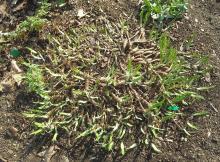
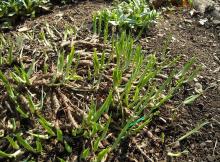
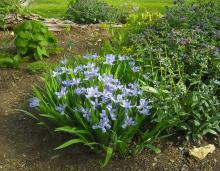
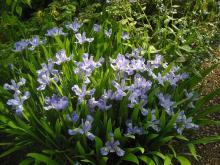
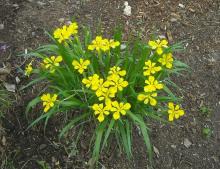
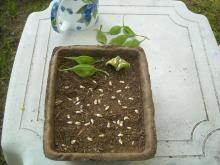
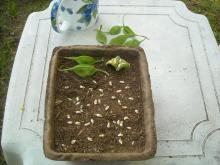
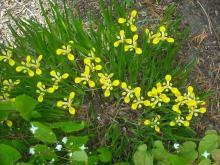
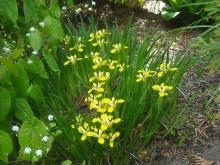
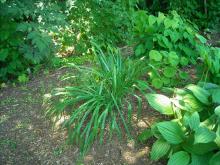
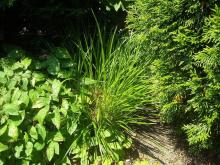
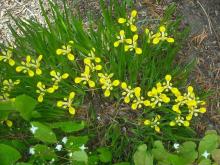
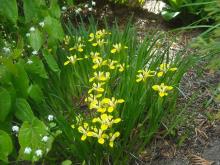
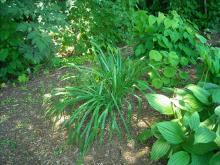
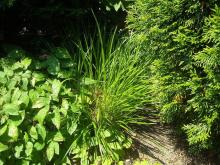
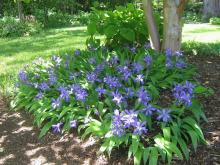
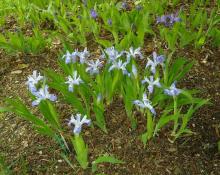
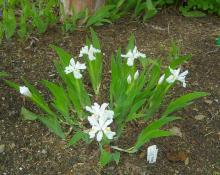
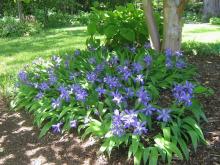
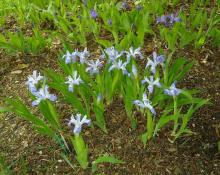
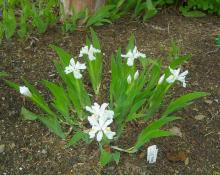
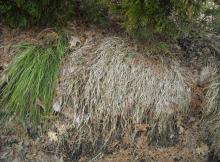
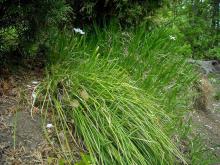
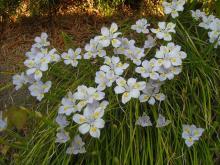
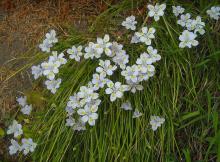
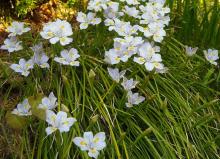
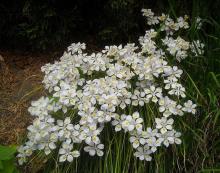

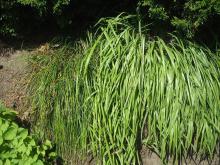
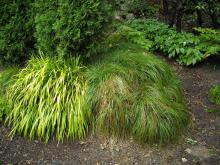
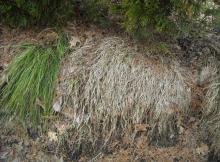
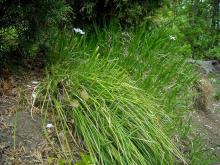
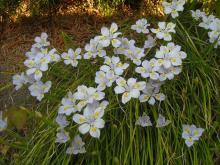
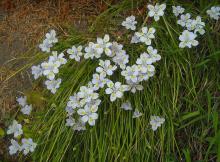
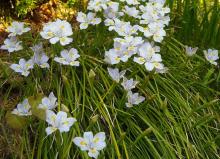
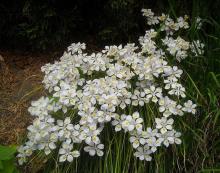
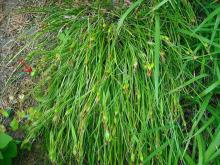
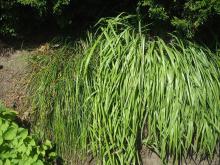
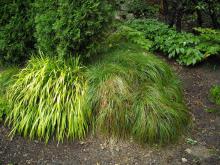
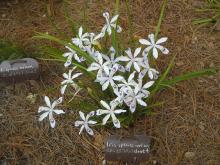
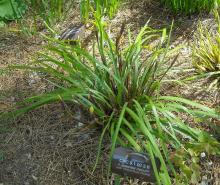
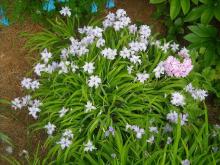
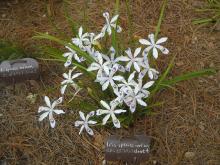
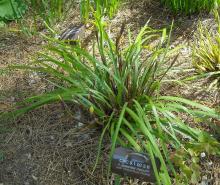
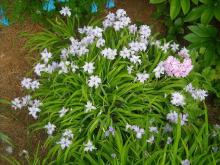
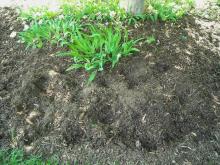
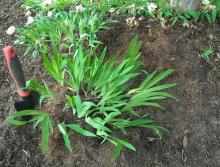
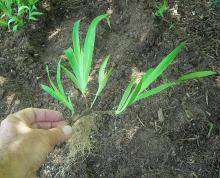
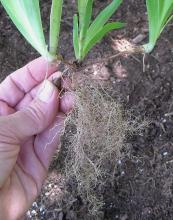
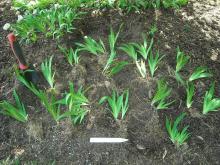
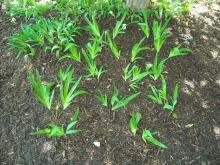
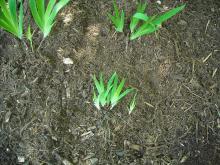
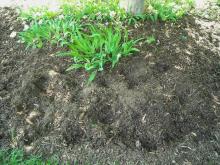
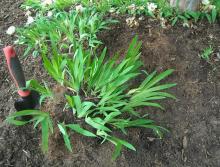
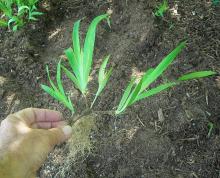
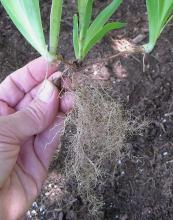
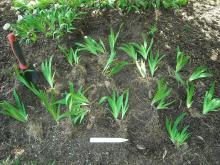
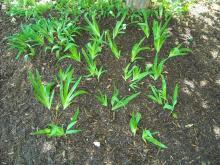
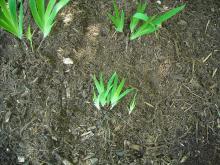
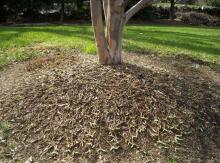
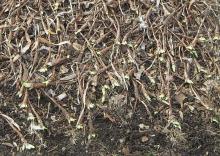
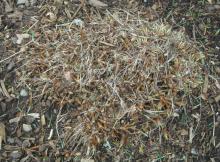
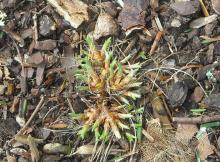
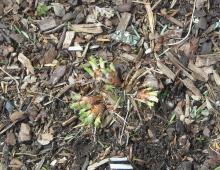
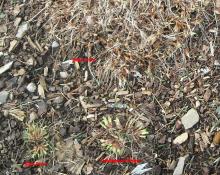
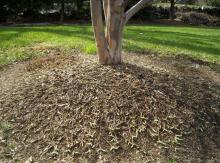
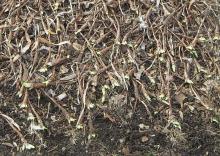
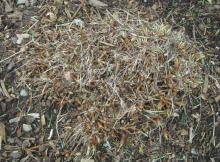
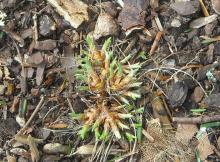
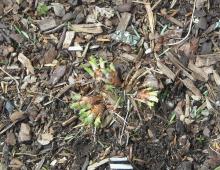
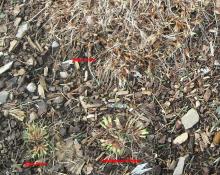
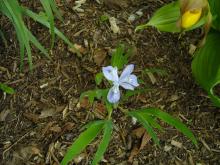
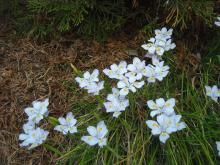
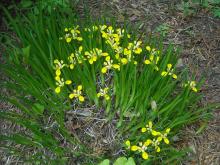
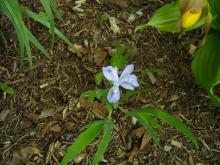
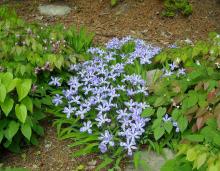
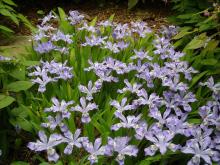
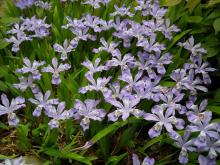
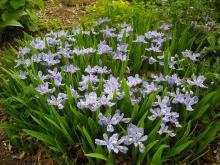
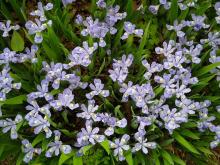
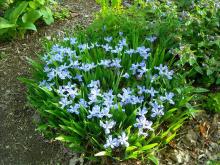
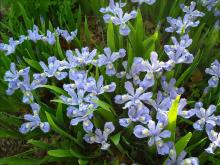
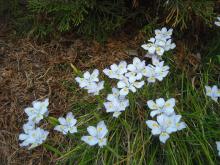
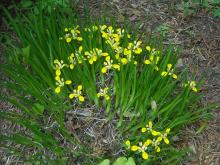
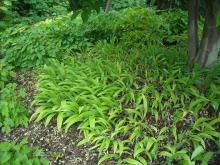
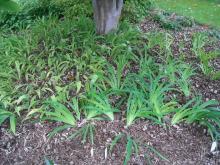
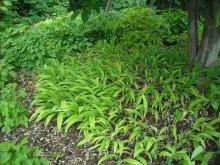
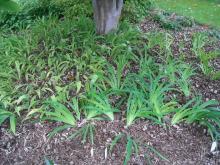
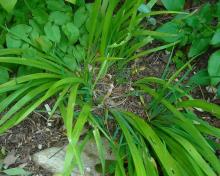
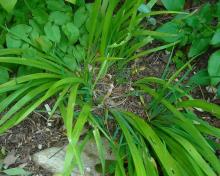
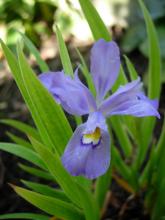
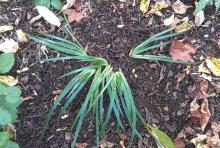
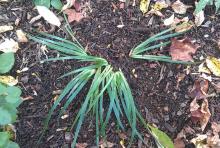
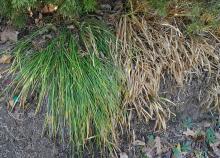
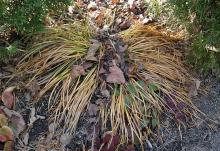
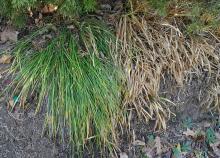


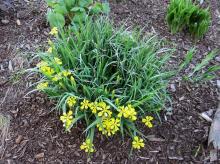
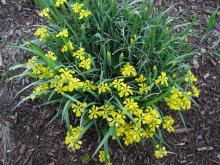
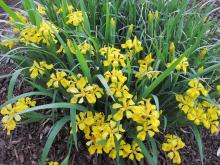
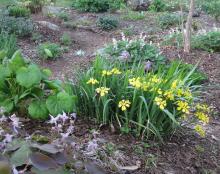
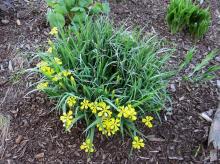
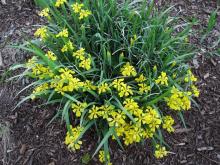
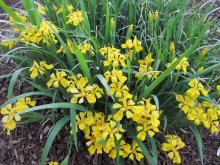
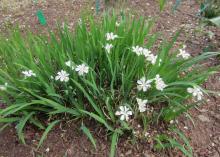
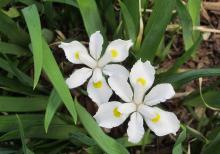
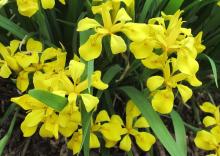
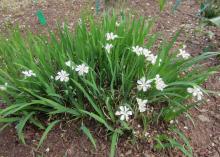
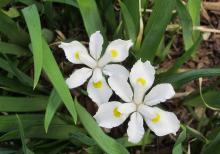
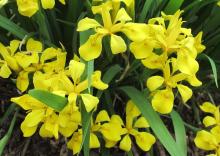
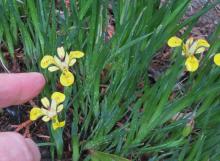
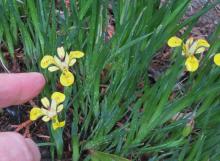
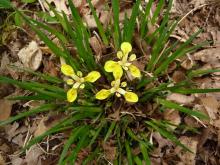
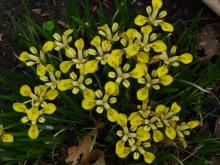
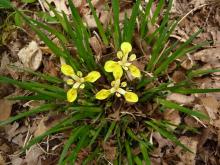
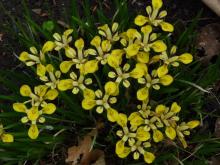
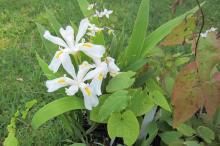
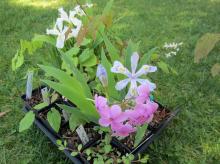
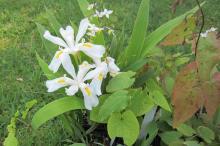
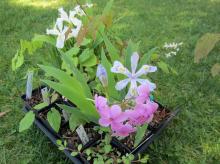
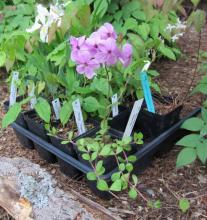
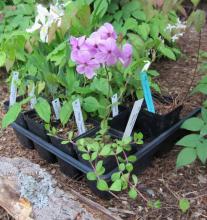
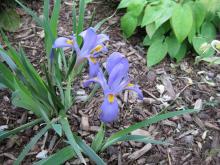
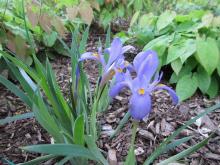
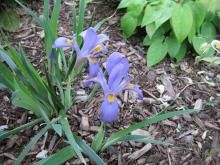
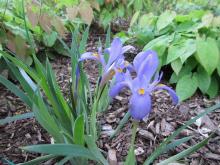
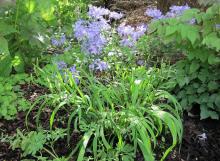
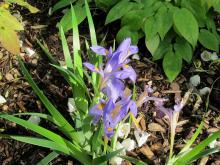

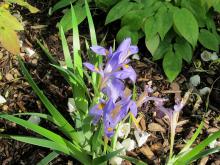
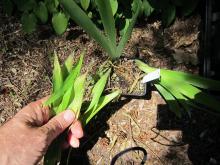

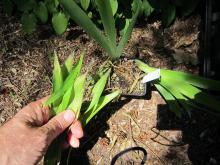
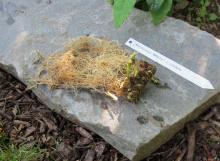
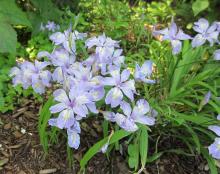
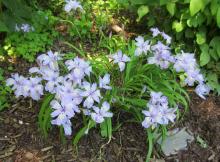
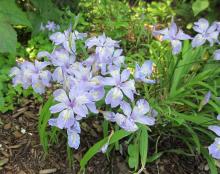
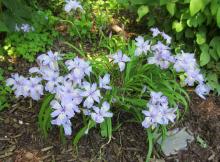
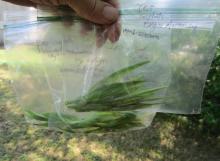
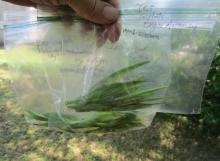
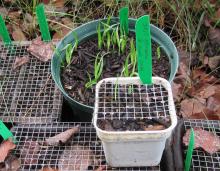
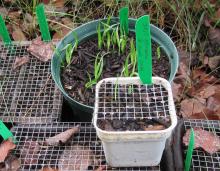
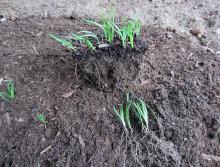
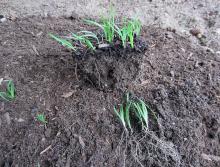
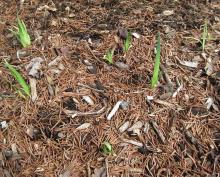
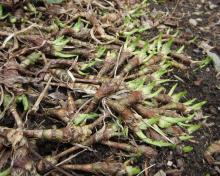
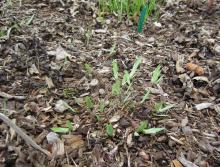
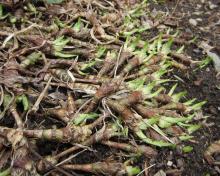
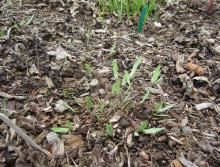
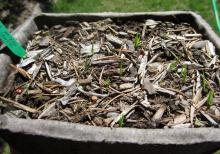
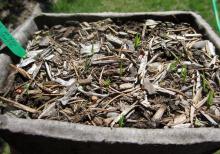
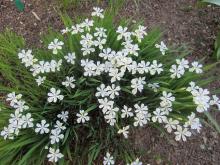
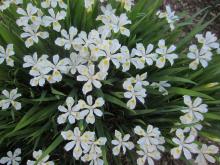
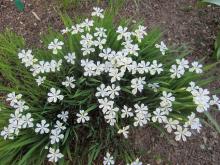
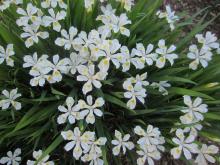
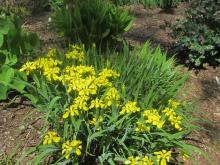
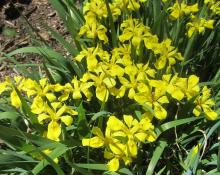

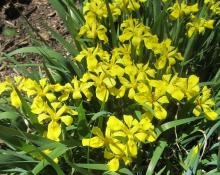
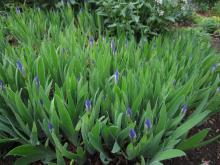
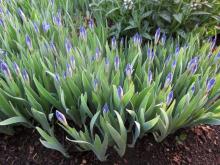
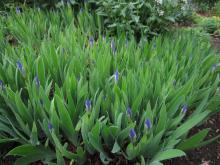

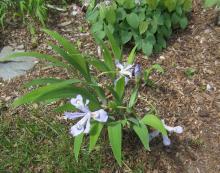
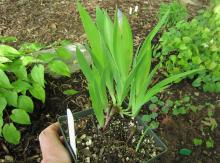
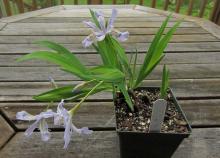
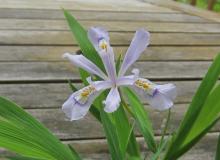
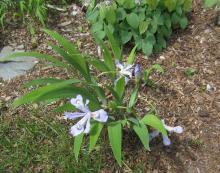
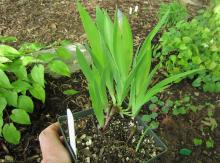
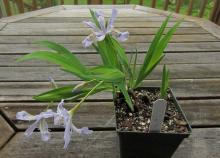
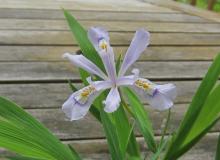
Two photos showing the mats of surface rhizomes on Iris cristata 'Edgar Anderson' in early April 2010, a relatively giant form of I. cristata, with the new growth more erect than most Iris cristata forms. One can tell from the start, the cultivar 'Edgar Anderson' is going to be larger than most cristata forms based on the vigorous tall shoots.
Iris cristata 'Edgar Anderson' flowered the same time as yellow Iris koreana, making me wonder about possible hybrids. Got a large batch of seed, all was sown. Most other Iris cristata varieties bloomed later when we had very hot days to 94-95 F (35 C), and as a result the flowers went by in just a couple days, and almost no seed set on those. Got one seed pod on I. cristata alba, which I sowed next to the mother plant.
For several years my Iris koreana barely flowered and shrank in size, so I moved it a couple years ago to a new location. I believe it was too dry where it was; the new location gets more light and has better humus-rich moisture retentive soil, and it jumped in size, flowered well, and now set lots of seed.
Interestingly, in 2010 Garden Vision Epimediums offered pre-sales on I. koreana "Select", reported as a "very floriferous clone" and "one that propagates well", promising that a cultivar name will be registered before the fall shipment.